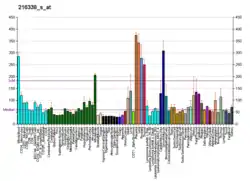YIPF3
Protein YIPF3 is a protein that in humans is encoded by the YIPF3 gene.[5] Along with YIPF4, it is concentrated in the cis-Golgi region. There the two form a complex and may be involved in the maintenance of the Golgi structure.[6]
| YIPF3 | |||||||||||||||||||||||||
|---|---|---|---|---|---|---|---|---|---|---|---|---|---|---|---|---|---|---|---|---|---|---|---|---|---|
| Identifiers | |||||||||||||||||||||||||
| Aliases | YIPF3, C6orf109, FinGER3, KLIP1, dJ337H4.3, Yip1 domain family member 3 | ||||||||||||||||||||||||
| External IDs | OMIM: 609775 MGI: 106280 HomoloGene: 9117 GeneCards: YIPF3 | ||||||||||||||||||||||||
| |||||||||||||||||||||||||
| |||||||||||||||||||||||||
| |||||||||||||||||||||||||
| |||||||||||||||||||||||||
| Orthologs | |||||||||||||||||||||||||
| Species | Human | Mouse | |||||||||||||||||||||||
| Entrez | |||||||||||||||||||||||||
| Ensembl | |||||||||||||||||||||||||
| UniProt | |||||||||||||||||||||||||
| RefSeq (mRNA) | |||||||||||||||||||||||||
| RefSeq (protein) | |||||||||||||||||||||||||
| Location (UCSC) | Chr 6: 43.51 – 43.52 Mb | Chr 17: 46.25 – 46.25 Mb | |||||||||||||||||||||||
| PubMed search | [3] | [4] | |||||||||||||||||||||||
| Wikidata | |||||||||||||||||||||||||
| |||||||||||||||||||||||||
See also
References
- GRCh38: Ensembl release 89: ENSG00000137207 - Ensembl, May 2017
- GRCm38: Ensembl release 89: ENSMUSG00000071074 - Ensembl, May 2017
- "Human PubMed Reference:". National Center for Biotechnology Information, U.S. National Library of Medicine.
- "Mouse PubMed Reference:". National Center for Biotechnology Information, U.S. National Library of Medicine.
- "Entrez Gene: YIPF3 Yip1 domain family, member 3".
- Kouji, Tanimoto; Kurumi, Suzuki; Eija, Jokitalo; et al. (2011). "Characterization of YIPF3 and YIPF4, cis-Colgi Localizing Yip Domain Family Proteins" (PDF). Cell Structure and Function. 36 (2): 171–185. doi:10.1247/csf.11002. PMID 21757827. Retrieved 30 May 2017.
Further reading
- Hartley JL, Temple GF, Brasch MA (November 2000). "DNA cloning using in vitro site-specific recombination". Genome Research. 10 (11): 1788–95. doi:10.1101/gr.143000. PMC 310948. PMID 11076863.
- Wiemann S, Weil B, Wellenreuther R, Gassenhuber J, Glassl S, Ansorge W, Böcher M, Blöcker H, Bauersachs S, Blum H, Lauber J, Düsterhöft A, Beyer A, Köhrer K, Strack N, Mewes HW, Ottenwälder B, Obermaier B, Tampe J, Heubner D, Wambutt R, Korn B, Klein M, Poustka A (March 2001). "Toward a catalog of human genes and proteins: sequencing and analysis of 500 novel complete protein coding human cDNAs". Genome Research. 11 (3): 422–35. doi:10.1101/gr.GR1547R. PMC 311072. PMID 11230166.
- Simpson JC, Wellenreuther R, Poustka A, Pepperkok R, Wiemann S (September 2000). "Systematic subcellular localization of novel proteins identified by large-scale cDNA sequencing". EMBO Reports. 1 (3): 287–92. doi:10.1093/embo-reports/kvd058. PMC 1083732. PMID 11256614.
- Prost S, LeDiscorde M, Haddad R, Gluckman JC, Canque B, Kirszenbaum M (2003). "Characterization of a novel hematopoietic marker expressed from early embryonic hematopoietic stem cells to adult mature lineages". Blood Cells, Molecules & Diseases. 29 (2): 236–48. doi:10.1006/bcmd.2002.0563. PMID 12490290.
- Wiemann S, Arlt D, Huber W, Wellenreuther R, Schleeger S, Mehrle A, Bechtel S, Sauermann M, Korf U, Pepperkok R, Sültmann H, Poustka A (October 2004). "From ORFeome to biology: a functional genomics pipeline". Genome Research. 14 (10B): 2136–44. doi:10.1101/gr.2576704. PMC 528930. PMID 15489336.
- Mehrle A, Rosenfelder H, Schupp I, del Val C, Arlt D, Hahne F, Bechtel S, Simpson J, Hofmann O, Hide W, Glatting KH, Huber W, Pepperkok R, Poustka A, Wiemann S (January 2006). "The LIFEdb database in 2006". Nucleic Acids Research. 34 (Database issue): D415-8. doi:10.1093/nar/gkj139. PMC 1347501. PMID 16381901.
This article is issued from Wikipedia. The text is licensed under Creative Commons - Attribution - Sharealike. Additional terms may apply for the media files.




